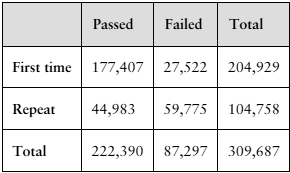The table below shows the results from a drug trial for a new ADHD medication. Use the table to find the probability that a person's symptoms didn't improve and they received the non-placebo and identify the type of probability found.
Table of contents
- 1. Intro to Stats and Collecting Data1h 14m
- 2. Describing Data with Tables and Graphs1h 55m
- 3. Describing Data Numerically2h 5m
- 4. Probability2h 16m
- 5. Binomial Distribution & Discrete Random Variables3h 6m
- 6. Normal Distribution and Continuous Random Variables2h 11m
- 7. Sampling Distributions & Confidence Intervals: Mean3h 23m
- Sampling Distribution of the Sample Mean and Central Limit Theorem19m
- Distribution of Sample Mean - Excel23m
- Introduction to Confidence Intervals15m
- Confidence Intervals for Population Mean1h 18m
- Determining the Minimum Sample Size Required12m
- Finding Probabilities and T Critical Values - Excel28m
- Confidence Intervals for Population Means - Excel25m
- 8. Sampling Distributions & Confidence Intervals: Proportion1h 25m
- 9. Hypothesis Testing for One Sample3h 57m
- 10. Hypothesis Testing for Two Samples4h 50m
- Two Proportions1h 13m
- Two Proportions Hypothesis Test - Excel28m
- Two Means - Unknown, Unequal Variance1h 3m
- Two Means - Unknown Variances Hypothesis Test - Excel12m
- Two Means - Unknown, Equal Variance15m
- Two Means - Unknown, Equal Variances Hypothesis Test - Excel9m
- Two Means - Known Variance12m
- Two Means - Sigma Known Hypothesis Test - Excel21m
- Two Means - Matched Pairs (Dependent Samples)42m
- Matched Pairs Hypothesis Test - Excel12m
- 11. Correlation1h 24m
- 12. Regression1h 50m
- 13. Chi-Square Tests & Goodness of Fit2h 21m
- 14. ANOVA1h 57m
4. Probability
Introduction to Contingency Tables
Problem 3.R.17
Textbook Question
In Exercises 17 and 18, use the table, which shows the numbers of first-time and repeat U.S. nursing students taking the National Council Licensure Examination (NCLEX-RN® exam) to pass or fail in a recent year. (Adapted from National Council Licensure Examinations)

17. Find the probability that a student took the exam for the first time, given that the student failed.
 Verified step by step guidance
Verified step by step guidance1
Step 1: Understand the problem. We are tasked with finding the conditional probability that a student took the exam for the first time, given that the student failed. This is a conditional probability problem, and the formula for conditional probability is P(A|B) = P(A ∩ B) / P(B).
Step 2: Identify the relevant data from the table. The number of students who failed the exam is 87,297 (this is P(B)). Out of these, the number of first-time students who failed is 27,522 (this is P(A ∩ B)).
Step 3: Write the formula for the conditional probability. Using the formula P(A|B) = P(A ∩ B) / P(B), substitute the values: P(First-time | Failed) = 27,522 / 87,297.
Step 4: Simplify the fraction. Divide the numerator (27,522) by the denominator (87,297) to calculate the probability. This will give the proportion of students who took the exam for the first time among those who failed.
Step 5: Interpret the result. The final value represents the likelihood that a student who failed the exam was taking it for the first time. Ensure the result is expressed as a decimal or percentage for clarity.
 Verified video answer for a similar problem:
Verified video answer for a similar problem:This video solution was recommended by our tutors as helpful for the problem above
Video duration:
4mPlay a video:
Was this helpful?
Key Concepts
Here are the essential concepts you must grasp in order to answer the question correctly.
Conditional Probability
Conditional probability refers to the likelihood of an event occurring given that another event has already occurred. In this context, we are interested in finding the probability that a student is a first-time test taker, given that they failed the NCLEX-RN exam. This is calculated using the formula P(A|B) = P(A and B) / P(B), where A is the event of being a first-time taker and B is the event of failing.
Recommended video:

Conditional Probability Rule
Joint Probability
Joint probability is the probability of two events happening at the same time. In this scenario, it refers to the probability that a student both failed the exam and is a first-time test taker. This is important for calculating conditional probabilities, as it provides the numerator in the conditional probability formula.
Recommended video:

Introduction to Probability
Total Probability
Total probability is the sum of the probabilities of all possible outcomes of an event. In this case, to find the probability of failing the exam, we need to consider both first-time and repeat test takers. The total number of failures is used as the denominator in the conditional probability formula, allowing us to determine the likelihood of a student being a first-time taker among those who failed.
Recommended video:

Introduction to Probability

 5:35m
5:35mWatch next
Master Introduction to Contingency Tables with a bite sized video explanation from Patrick
Start learningRelated Videos
Related Practice
Multiple Choice
157
views
3
rank
